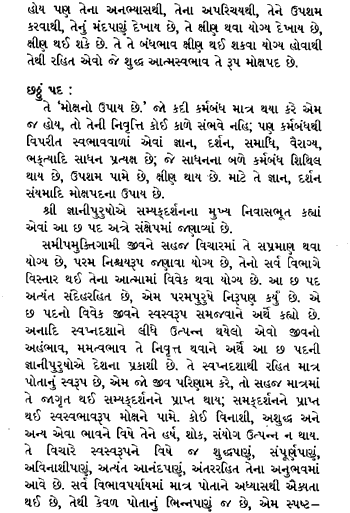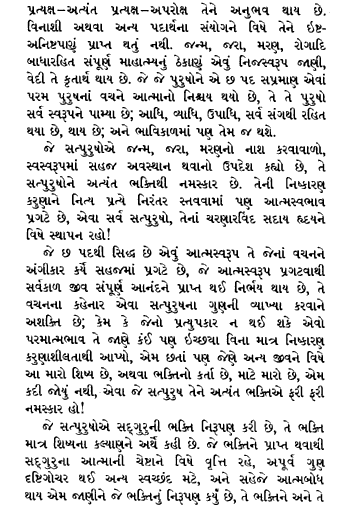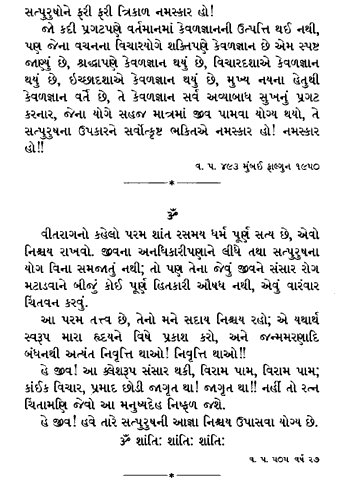Site menu:
 Six Fundamental Truths
Six Fundamental Truths
Sorty behind Letter of Six Fundamental Truths (6 pad no patra)
Shri Lalluji Maharaj being sick in Surat requested Shrimadji for Samadhi Maran. In reply, Shrimadji wrote the famous letter of six fundamental truths, and inspired Lalluji Maharaj not to fear death.
This letter is the theme, of which "Atmasiddhi" is the development. Shri Lalluji Maharaj appreciates this letter as follows:
"This letter has helped us to remove all our stray ideas and wandering thoughts, it has removed our doubts, confirmed our faith in the fundamentals of Jainism and those of all religions in general, namely the nature and development of soul.
It has taken us out of our prejudicial attachments to the Jain sects; it has kept us clear of fixing our faith in the Vedanta; it has, in brief, re-established our pursuits in the nature of the Self and its knowledge.
Thus, this letter is uniquely wonderful in many ways. If the disciple is deserving, the constant meditation on this letter, on the truths contained in it, would put him to the path of Self-realization."
 Click here to view "cha pad no patra" in krupaludev's original handwriting.
Click here to view "cha pad no patra" in krupaludev's original handwriting.
Six Fundamental truths





The letter is as follows:
With intense devotion I bow to the true Guide, the bestower of unique refuge.
The enlightened, who have attained true knowledge of Self have described the following six fundamentals as the supreme abode of right perception.
First fundamental:- 'There is existence of soul.' As there is existence of physical objects like pot, cloth, etc. so is the existence of soul. As the properties of pot, cloth, etc. are the evidence of their existence, so the obvious property of consciousness to manifest itself as well as others, is the evidence of the existence of soul.
Second fundamental:- 'Soul is eternal'. Pot, cloth, etc. stay as such for some time; but soul stays forever. Pot, cloth, etc. are composed of some materials, but soul is a substance on its own, because no composition can be visualized for producing soul. Consciousness cannot arise out of any composition, so it is not a product. Being incomposible, it is nonperishable; because what cannot be produced by any composition, can not merge in anything else.
Third fundamental:- "Soul is Kartä'. All objects are associated with purposeful activity. All of them are seen with some or other process that causes alterations. Soul also is imbibed with activity. Having the actuation., it is Kartä. The omniscient Lords have described three types of such actuation. In absolute state when soul stays tuned to its pure nature, it is the Kartä of that nature; in normal practice (which can be experienced; which comes in close contact), it is the Kartä of material Karma; and nominally it is the Kartä of physical objects like buildings, towns, etc.
Fourth fundamental:- 'Soul bears consequences of its action'. All activities are fruitful; they are not futile. It is the obvious experience that whatever is done, has its consequences. Consumption of poison or sugar and contact with fire or snow do not fail to produce their respective consequences. Similarly, if soul indulges in defiled or undefiled state, that state too is bound to be fruitful and it produces consequences. Thus being Kartä, soul bears the consequences as well.
Fifth fundamental:- 'There is liberation'. Soul has been described above as being Kartä of material Karmas and as such being subject to their consequences, Those Karmas can, however, be terminated as well; because even if prevailing defilement etc. are very acute, they can be reduced by discontinuance of practice, by avoiding contact and by calming them down. They are reducible and can be destroyed. The state of the bondage thus being destructible, pure state of soul devoid of all bondage, is the state of liberation.
Sixth fundamental:- 'There are means to achieve liberation'. If bondage of Karma simply continues to occur, its cessation can never be visualized. There are, however, factors like knowledge, conviction, staying tuned to soul, detachment, devotion etc. that are manifestly opposites of the bondage of Karma. By the intensity of these means, the bondage gets loose, gets pacified and can be destroyed. Therefore knowledge, perception, restraint etc. are the means for attaining liberation.

